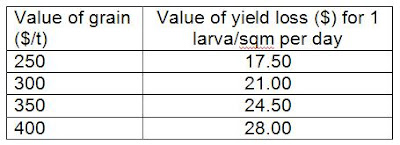Armyworm in wheat
1) Do they behave the same way in wheat as in barley in relation to the type of damage they cause
2) what is their damage potential and is there an economic threshold?
3) What sort of strategy can be used to monitor and manage populations?
For information on armyworm identification see previous Beatsheet postings on armyworms.
http://thebeatsheet-ipmnews.blogspot.com/2007/10/can-you-confidently-identify-armyworm.html
http://thebeatsheet-ipmnews.blogspot.com/2007/09/watch-for-armyworms-in-barley-and-oats.html
There is no reason to expect armyworm to behave differently in wheat to barley. This means you can expect to see feeding on leaves whilst the crop is still green, and then on stems as the crop dries down further.
Characteristic armyworm damage in winter cereals
During the vegetative growth phase, plants can tolerate considerable leaf feeding. Leaves may look tattered from the eaten-out leaf margins. Faecal pellets around the base of plants are another indication of armyworm infestation. Armyworm generally do not require control during the vegetative stage.

Ragged flag and other leaves on a maturing barley crop
The most serious armyworm damage in cereal crops occurs when larvae feed on the upper flag leaf and stem node as the crop matures. Larvae target the stem node as the leaves become dry and unpalatable, and the stem is often the last part of the plant to dry. Head cutting begins at this time.
 Head cutting in barley caused by armyworm
Head cutting in barley caused by armywormCalculating an economic threshold
The following table shows the value of yield loss incurred by 1 larva/square m per day, based on approximate current values for wheat and an estimated loss of 70 kg/ha per larva.
 Based on these figures, and the relatively low cost of controlling armyworm, populations in ripening crops in excess of 1 large larva per square metre will warrant spraying.
Based on these figures, and the relatively low cost of controlling armyworm, populations in ripening crops in excess of 1 large larva per square metre will warrant spraying.Monitoring and management strategy
For insecticide application to be economic, check or scout the crop and assess the problem before head cutting starts. Check for larvae on the plant and in the soil litter under the plant. Late in the day, when the larvae are becoming active, use a sweep net (or swing a bucket through the crop) to make a quick assessment of whether armyworm larvae are present in the crop. Infestations are often patchy, so check a number of sites across the field.
Some judgements will need to be made about how quickly the larvae will reach damaging size and when this will occur in relation to the crop's development.For example, if the crop is nearing full maturity/harvest, and the grubs are still small, then there is most likely no need to spray. Small larvae take 8-10 days to reach a size capable of head lopping.The other extreme would be a late crop that is still very green and at early seed fill. In this case, any small larvae present will most likely reach their most damaging size in time to significantly reduce crop yield, and so a spray is more likely to be required.
I you are unable to monitor the crop on a regular (daily) schedule during the critical period of drying down, and armyworm are present, it may be better to spray just in case. This is not the preferred option, but provides peace of mind in a year like this where armyworm are abundant.
Early recognition
It is essential to recognise the problem early and be prepared to spray when economic damage is imminent. A cereal crop can be almost destroyed by armyworm in just a few days. Whilst large larvae do the head lopping, controlling smaller larvae that are still leaf feeding may be more achievable.
Control
Many chemicals will control armyworms. However their effectiveness is often dependent on good penetration into the crop to get contact with the caterpillars. Control may be more difficult in high-yielding thick canopy crops, particularly when larvae are resting under leaf litter at the base of plants. As larvae are most active at night, spraying in the afternoon or evening may produce the best results.
If applying sprays close to harvest, be aware of relevant Withholding Periods. Always read the label.
Biological control agents may be important in some years. These include parasitic flies and wasps, predatory beetles and diseases.
Labels: armyworm, wheat, Winter cereals

0 Comments:
Post a Comment
Subscribe to Post Comments [Atom]
<< Home